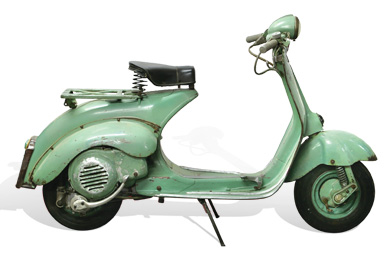Postage free from 99€ (DE)
High customer satisfaction

The "U" (utilitaria = practical) was Piaggio's economy model and quite a flop: anyone who had enough money at the time bought the next best model. For this reason, only around 2,000 of the 6001 vehicles built were sold. In 1955, 3,500 of them went to Iran (after standing in Piaggio's stockpile for two years), where they were then converted for the post office with a huge luggage rack plate plus front carrier. What happened to the remaining 500 or so bikes has still not been discovered. However, it is precisely the relatively small number of units combined with the unusual appearance that makes the "U" a sought-after collector's item, for which - if one is offered at all - prices in the 5-digit range are called for.
The most striking features of the "U" are the engine cheek, which has been degraded to a cover plate, and the relatively small headlight, which sits on the handlebars for the first time on an Italian Vespa. The hood is chamfered on the frame and visibly bolted to the frame with 4 slotted screws. The likewise smaller luggage compartment jaw is also fastened in this way with 8 screws; a gray rubber profile is underlaid in each case. The neutered design of the hood allows the spark plug to be removed without hindrance; the luggage compartment lid has no lever and must be lifted using a small raised section and a molded spring. The "U" is the first Italian model in which the headlight is located on the handlebars. The relatively small cast aluminum headlight with Ø 95 mm is only fitted on this model and its trim ring is the only chrome-plated part of the entire scooter. The front mudguard is smaller and narrower than on the more expensive model and is shaped for the steering tube and damper spring. As on the V15T model from 1950, the front swingarm has no hydraulic shock absorber. The smaller saddle with dark green painted springs has no front spring. The brake pedal is made of unpolished aluminum and has a cast-in waffle pattern rather than rubber. The rear light is taken from the V33T. The tread strips are made of stamped aluminum without rubber inserts and are only available twice on both sides and on the tunnel. For economic reasons, most parts of the entire Vespa are painted (frame, lamp and tail light housing, saddle springs, handlebars and handlebar clamps, steering tube, swingarm and rims, cylinder cover and fan cover), even the Vespa lettering on the leg shield is only painted on. The zinc side stand is made of round material offset by 30 mm at the top and bottom and has no rubber base. The light switch has a gray plastic cover as on the VM1T from 1953. There is no handlebar lock and the tank cap is loosely screwed on.
The engine consists of components from the VM1T from 1953 (gearbox, clutch, ignition base plate and pole wheel) and remnants from engines from 1951 (cylinder, crankshaft, Lüra cover, cylinder cover). The kickstarter is made of unpolished aluminum with a waffle pattern without rubber coating, the fuel tap is inside under the carburetor flap. (Source: GSF)
Frame numbers by year of manufacture:
1953: VU1T 1001-7001
Quantity: 6,001


